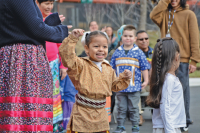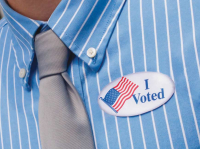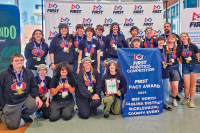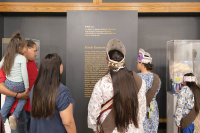Sam Love Queen and the values of Folkmoot
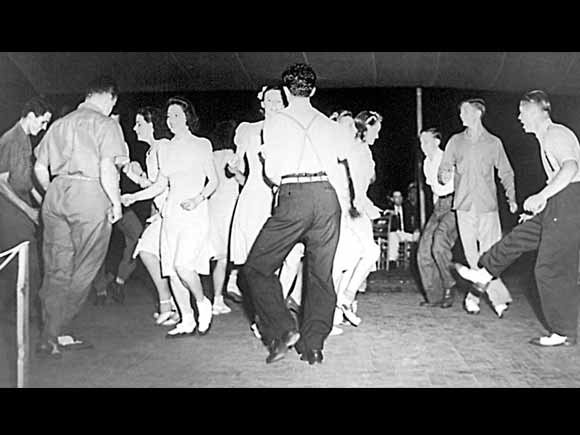
In May, the auditorium in the Folkmoot Friendship Center was dedicated to a man instrumental in establishing Waynesville and its environs as one of the most important centers of folk culture in the nation.
Aside from his work as a square dancer and square dance caller, as well as his reputation for being “the dancing-est man in all the land,” the story of how that man came to be so honored is today the stuff of legend.
On the morning of Thursday June 8, 1939, the world stood at the brink of war as President Franklin Delano Roosevelt and First Lady Eleanor Roosevelt stood on a train platform, waiting to meet a queen and a king.
Haywood County Native Sam Love Queen, the “King of the Square Dance,” was on his way to the White House.
The Roosevelts would indeed meet Queen, but they were actually waiting that morning at the beautiful Daniel Burnham-designed Union Station in Washington, D.C., for a different queen and king.
Shortly after 10:30 a.m. the first reigning British monarch to set foot on American soil — King George VI — stepped off a train with his wife, Queen Elizabeth.
Related Items
By noon they had been shown to their rooms at the White House. Thirty minutes later they were received by diplomats in the East Room. Around 2 p.m., they joined the Prime Minister of Canada, William L. Mackenzie King, for lunch. An hour later, the President took the king and queen on a sightseeing tour by car, and then to a garden party at the British Embassy.
King George’s visit to the city named after England’s most loathed rebel was given the usual fanfare afforded a foreign dignitary, but there was serious business at hand given Adolph Hitler’s increasingly alarming actions in Europe. Less than three weeks earlier, he’d signed the “Pact of Steel” with Mussolini’s fascist Italy and would go on to sign a non-aggression pact with Stalin’s Soviet Union August 23.
Two days after that, Great Britain signed a mutual assistance treaty with Poland, which was invaded by Germany eight days after that, marking the beginning of a six-year conflagration known as World War II that would leave more than 70 million dead.
But on that harried, hectic afternoon in June, Hitler was already known to be eyeing Poland.
Thus King George had the unenviable task of courting the support of Roosevelt’s depression-plagued America, where resentment over getting tangled up in Britain’s World War I effort still lingered and the armed forces were but an outdated skeleton crew.
As the afternoon drew to a close, Roosevelt — in no great rush to join another distant, brutal European scrum — went swimming.
He rejoined the king and queen in the State Dining Room at 8 p.m. as dinner for 86 was served. At 10, the entertainment for the evening began.
According to White House Records, 325 people were invited to the “Musicale,” and 324 attended; whoever missed that event missed out on a chance to see not only the leaders of powerful nations, but also leaders in the promotion and preservation of contemporary American folk culture of the time.
Rather than invite an orchestra or opera — both of which hold distinctly European roots — to perform, and perhaps as a demonstration to the king and queen of how American culture had held true to, but developed independently of, its ancestral British source, Eleanor Roosevelt tapped Charlie Seeger, an American musicologist (and father of legendary folk singer Pete Seeger) to organize the event.
Another prominent American musicologist, Alan Lomax, was also present, although in a slightly different capacity than that for which he is best known by audiophiles today. From 1937 to 1942, Lomax served as Assistant in Charge of the Archive of Folk Song of the Library of Congress, during which time he traveled across the country with a tape recorder gathering oral histories focusing on authentic folk culture. In the process, he made precious and irreplaceable recordings of Woody Guthrie, Jelly Roll Morton, and McKinley Morganfield — better known as Muddy Waters — before most people had even heard of them.
That night, Lomax played the banjo and sang, performing the cowboy ballads “Whoopee, Ti Yi Yo, Get Along, Little Dogies” and “The Old Chisholm Trail,” just after the North Carolina Spiritual Singers performed Nell Hunter’s arrangements of three old Negro spirituals — “De Ol’ Ark’s A Moverin,” “Wade in the Water” and “I Don’t Feel Noways Tired.”
The end of the evening was Sam Love Queen’s time to shine. Queen’s Soco Gap Square Dance Team — by then, nationally renowned — demonstrated “dances handed down through generations” by “rural people from the mountains of Western North Carolina, near Asheville, most of whom live on their own farms where they raise fruit, grow stock and do diversified farming.”
Queen’s team performed such dances as the Wagon Wheel, the Ocean Wave, the King’s Highway, Dive and Shoot the Owl, and, fittingly, the London Bridge.
In a 1981 interview, Lomax recalled that the king and queen were “right up close to the edge of the stage. I don’t think I was ever more frightened in my whole life. Roosevelt was on the front row with his head cocked over, smiling and swinging in time to the music,” he said. “Oh, yes, he loved that concert, he was having a ball.”
Legend has it that Queen Elizabeth — mother of England’s current Queen Elizabeth — remarked that the Soco Gap Square Dancers’ performance reminded her of a dance from Wales, called clogging. This is, supposedly, how the dance got its name.
Roosevelt has always been known as a cultured president, especially for his time, and the fact that he’d chosen an integrated group of performers — Nell Hunter was African American, as were the Works Progress Administration-backed North Carolina Spiritual Singers — further demonstrated to the king and queen that American diversity is an asset, not a liability. Sam Love Queen had also learned many of his dances from Bob Love, an African-American blacksmith from Waynesville.
Around midnight the entertainment ended, but the king and queen’s visit continued, culminating in what is known as the “hot dog summit” three days later.
Roosevelt served the king and queen hot dogs in Hyde Park, New York, much to the horror of his more “civilized” advisors. As they all discussed the ominous situation in Europe, a turning point in international relations was then and there reached — the luncheon prompted Roosevelt to begin advocating to Congress on behalf of Great Britain, even though the queen ate her hot dog with a fork and knife.
And although Sam Love Queen didn’t have much to do with the rest of their visit, his presence as an ambassador of Maggie Valley, of Haywood County, of North Carolina and of the United States brought him, for one night, to center stage at an important global summit where Americans demonstrated both their past and their present while its leaders demonstrated their unwillingness to live in a future where the values of Folkmoot — peace, love and international friendship — could be infringed upon by a Nazi regime based on warmongering, racial superiority and religious extremism.
Important information in this story was garnered from the file “Soco Gap Dancers at the White House,” from the Square Dance History Project, accessed July 25, 2016,





